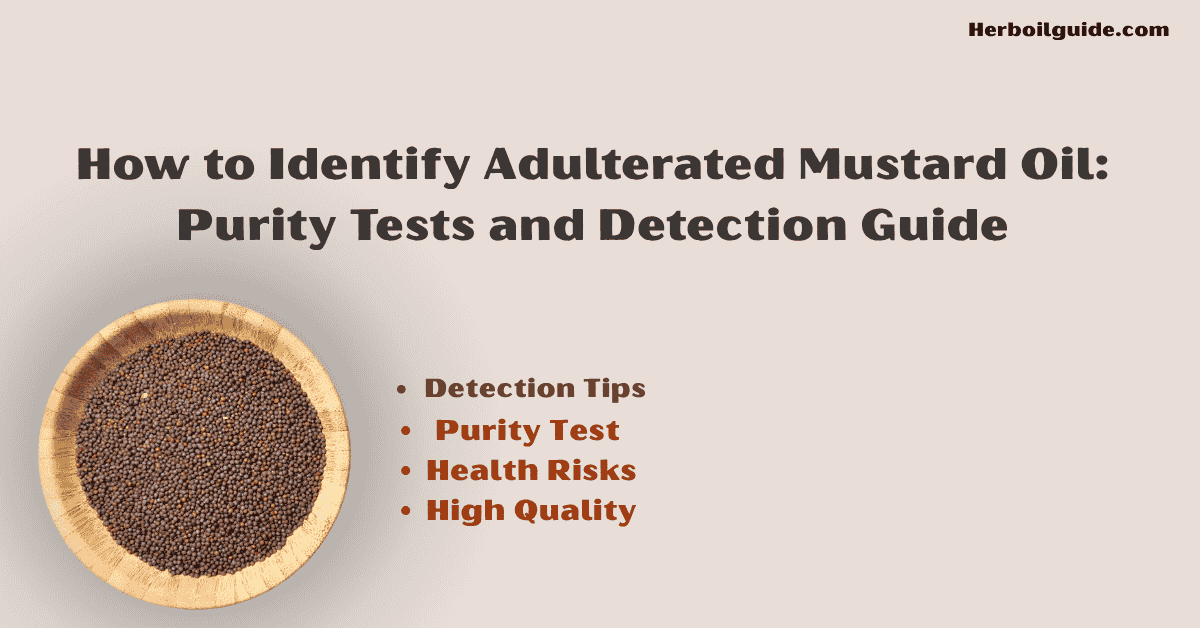How to Identify Adulterated Mustard Oil: Purity Tests & Detection Guide

Mustard oil is valued for its pungent aroma, rich flavor, and numerous health benefits. However, the prevalence of adulterated mustard oil in the market poses significant health risks. This guide provides practical methods to detect adulteration and ensure the purity of your mustard oil.
⚠️ Common Adulterants in Mustard Oil
Adulteration is often done to cut costs, but it compromises the oil's quality and can be dangerous. Be aware of these common adulterants:
- Argemone Oil: A toxic oil that can cause epidemic dropsy, a condition leading to swelling, glaucoma, and even death.
- Palm Oil: Often mixed in to reduce costs, it alters the nutritional profile of mustard oil and heart-healthy benefits of pure mustard oil.
- Mineral Oils: These are non-edible petroleum-based oils that can lead to severe health issues when consumed.
- Synthetic Additives: Artificial colors and flavors are sometimes used to mimic the appearance and aroma of pure mustard oil.
🏠 Home-Based Purity Tests
You can perform several simple tests at home to check for adulteration before using the oil.
1. The Smell Test
Pure mustard oil has a sharp, pungent aroma characteristic of mustard seeds. A very faint or non-existent smell may indicate adulteration or excessive refining.
2. The Freezing Test
Place a small bowl of mustard oil in the refrigerator for a few hours. Pure mustard oil will not change its state. If the oil solidifies, freezes, or develops white spots, it is likely adulterated with other oils like palm oil.
3. The Water Test
Add a few drops of mustard oil to a glass of water. Pure oil is less dense and will float on top without mixing. Adulterated oil may form a cloudy layer or mix with the water, indicating the presence of soluble impurities.
4. The Rubbing Test
Rub a small amount of oil between your palms. Pure mustard oil will feel non-greasy and will not leave any color. If your palms feel greasy, have a chemical smell, or show a trace of color, the oil may be adulterated.
5. The Nitric Acid Test
In a test tube, mix equal parts of mustard oil and nitric acid. Shake the tube gently. Pure mustard oil will not show any color change. A color change to reddish, orange, or yellowish indicates the presence of harmful adulterants like argemone oil. (Note: Handle nitric acid with extreme care).
6. The Foaming Test
Heat a small amount of mustard oil in a pan. If the oil foams excessively or produces a soapy lather, it may contain soap or detergent-like substances.
🧪 Laboratory-Based Detection Methods
For more definitive results, especially for commercial purposes, laboratory testing is recommended:
- Chromatography: This technique effectively separates the components of mustard oil to detect specific adulterants like argemone oil.
- NMR Spectroscopy: Nuclear Magnetic Resonance (NMR) can identify adulterants such as rice bran and palm oil by analyzing the oil's molecular structure.
- Spectroscopy & Biochemical Methods: Advanced methods like FT-NIR spectroscopy offer rapid and accurate detection of a wide range of adulterants.
🏛️ Regulatory Standards and Certifications
Tips for how to choose and buy mustard oil, look for these certifications on the packaging to ensure product authenticity and safety:
- FSSAI (Food Safety and Standards Authority of India): Ensures food safety and quality in India.
- AGMARK: A certification mark for agricultural products in India, indicating conformity to a set of standards.
- ISO Certifications: International standards that assure quality, safety, and efficiency.
🛒 Tips for Purchasing Pure Mustard Oil
- Buy from Reputable Brands: Established brands are more likely to adhere to strict quality control standards.
- Check for Certifications: Always look for FSSAI, AGMARK, or ISO certifications on the label.
- Avoid Unusually Low Prices: If the price seems too good to be true, the product is likely compromised or adulterated.
- Inspect Packaging: Ensure the bottle or container is properly sealed and free from any signs of tampering.
❓ FAQs
Q: Can I use expired mustard oil for skin or hair?
A: It's not recommended. Degraded or rancid oil can cause skin irritation, clog pores, and will have lost its beneficial properties. Always check the smell and color before any use.
Q: Should mustard oil be refrigerated?
A: Not necessary, but storing in a cool, dark place helps prolong freshness. Avoid exposing it to direct sunlight or stove heat.
Q: How can I tell if mustard oil has gone bad?
A: Check for changes in smell (sour or rancid), appearance (cloudiness or sediment), and taste. Spoiled oil may also feel sticky.